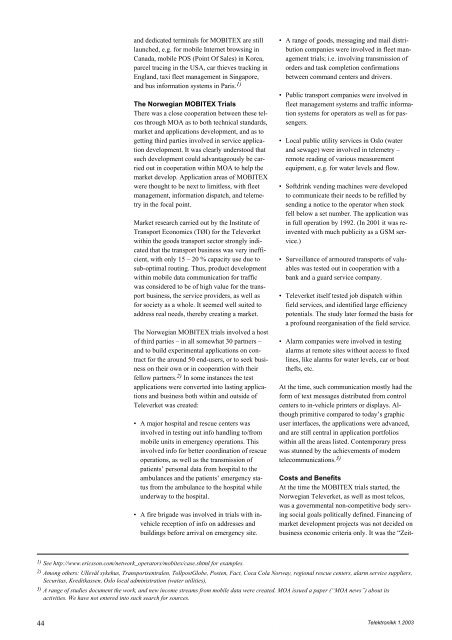Intelligent Transport Systems - Telenor
Intelligent Transport Systems - Telenor
Intelligent Transport Systems - Telenor
You also want an ePaper? Increase the reach of your titles
YUMPU automatically turns print PDFs into web optimized ePapers that Google loves.
44<br />
and dedicated terminals for MOBITEX are still<br />
launched, e.g. for mobile Internet browsing in<br />
Canada, mobile POS (Point Of Sales) in Korea,<br />
parcel tracing in the USA, car thieves tracking in<br />
England, taxi fleet management in Singapore,<br />
and bus information systems in Paris. 1)<br />
The Norwegian MOBITEX Trials<br />
There was a close cooperation between these telcos<br />
through MOA as to both technical standards,<br />
market and applications development, and as to<br />
getting third parties involved in service application<br />
development. It was clearly understood that<br />
such development could advantageously be carried<br />
out in cooperation within MOA to help the<br />
market develop. Application areas of MOBITEX<br />
were thought to be next to limitless, with fleet<br />
management, information dispatch, and telemetry<br />
in the focal point.<br />
Market research carried out by the Institute of<br />
<strong>Transport</strong> Economics (TØI) for the Televerket<br />
within the goods transport sector strongly indicated<br />
that the transport business was very inefficient,<br />
with only 15 – 20 % capacity use due to<br />
sub-optimal routing. Thus, product development<br />
within mobile data communication for traffic<br />
was considered to be of high value for the transport<br />
business, the service providers, as well as<br />
for society as a whole. It seemed well suited to<br />
address real needs, thereby creating a market.<br />
The Norwegian MOBITEX trials involved a host<br />
of third parties – in all somewhat 30 partners –<br />
and to build experimental applications on contract<br />
for the around 50 end-users, or to seek business<br />
on their own or in cooperation with their<br />
fellow partners. 2) In some instances the test<br />
applications were converted into lasting applications<br />
and business both within and outside of<br />
Televerket was created:<br />
• A major hospital and rescue centers was<br />
involved in testing out info handling to/from<br />
mobile units in emergency operations. This<br />
involved info for better coordination of rescue<br />
operations, as well as the transmission of<br />
patients’ personal data from hospital to the<br />
ambulances and the patients’ emergency status<br />
from the ambulance to the hospital while<br />
underway to the hospital.<br />
• A fire brigade was involved in trials with invehicle<br />
reception of info on addresses and<br />
buildings before arrival on emergency site.<br />
• A range of goods, messaging and mail distribution<br />
companies were involved in fleet management<br />
trials; i.e. involving transmission of<br />
orders and task completion confirmations<br />
between command centers and drivers.<br />
• Public transport companies were involved in<br />
fleet management systems and traffic information<br />
systems for operators as well as for passengers.<br />
• Local public utility services in Oslo (water<br />
and sewage) were involved in telemetry –<br />
remote reading of various measurement<br />
equipment, e.g. for water levels and flow.<br />
• Softdrink vending machines were developed<br />
to communicate their needs to be refilled by<br />
sending a notice to the operator when stock<br />
fell below a set number. The application was<br />
in full operation by 1992. (In 2001 it was reinvented<br />
with much publicity as a GSM service.)<br />
• Surveillance of armoured transports of valuables<br />
was tested out in cooperation with a<br />
bank and a guard service company.<br />
• Televerket itself tested job dispatch within<br />
field services, and identified large efficiency<br />
potentials. The study later formed the basis for<br />
a profound reorganisation of the field service.<br />
• Alarm companies were involved in testing<br />
alarms at remote sites without access to fixed<br />
lines, like alarms for water levels, car or boat<br />
thefts, etc.<br />
At the time, such communication mostly had the<br />
form of text messages distributed from control<br />
centers to in-vehicle printers or displays. Although<br />
primitive compared to today’s graphic<br />
user interfaces, the applications were advanced,<br />
and are still central in application portfolios<br />
within all the areas listed. Contemporary press<br />
was stunned by the achievements of modern<br />
telecommunications. 3)<br />
Costs and Benefits<br />
At the time the MOBITEX trials started, the<br />
Norwegian Televerket, as well as most telcos,<br />
was a governmental non-competitive body serving<br />
social goals politically defined. Financing of<br />
market development projects was not decided on<br />
business economic criteria only. It was the “Zeit-<br />
1) See http://www.ericsson.com/network_operators/mobitex/case.shtml for examples.<br />
2) Among others: Ullevål sykehus, <strong>Transport</strong>sentralen, TollpostGlobe, Posten, Fact, Coca Cola Norway, regional rescue centers, alarm service suppliers,<br />
Securitas, Kreditkassen, Oslo local administration (water utilities),<br />
3) A range of studies document the work, and new income streams from mobile data were created. MOA issued a paper (“MOA news”) about its<br />
activities. We have not entered into such search for sources.<br />
Telektronikk 1.2003
















